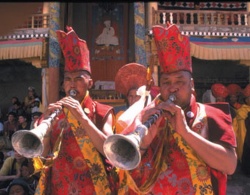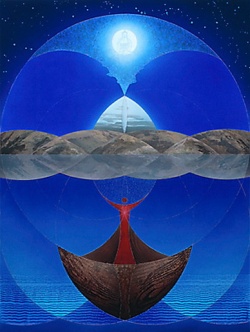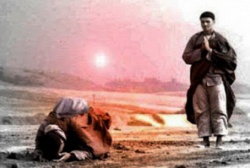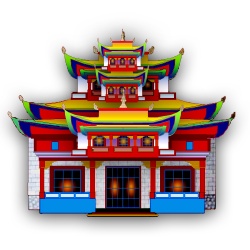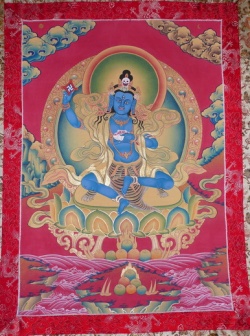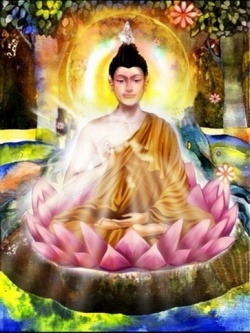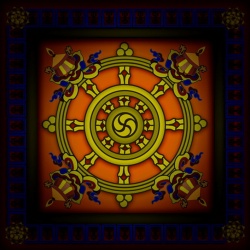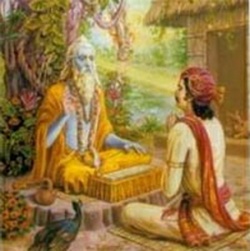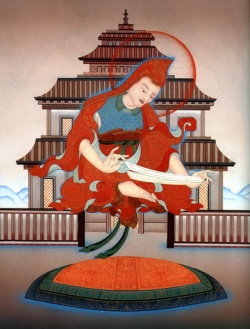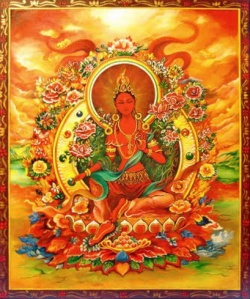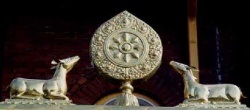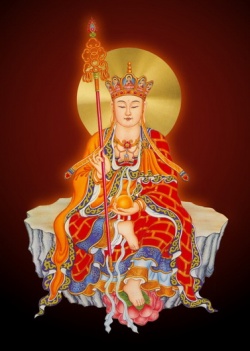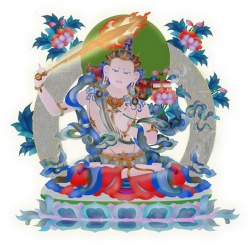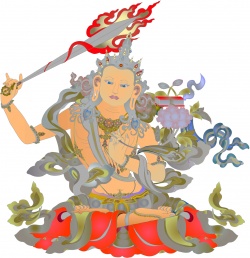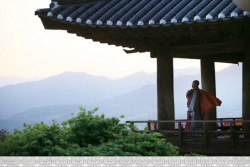Difference between revisions of "Svayambhu Mahacaitya: A survival of Indic Buddhism in Kathmandu valley by Min Bahadur shakya"
(Created page with "{{Centre|<big><big>Svayambhu Mahacaitya:<br/> A survival of Indic Buddhism in Kathmandu valley</big></big><br/> by<br/> Min Bahadur shakya<br/> Director<br/> Nagarjuna Institu...") |
|||
| Line 1: | Line 1: | ||
| + | {{DisplayImages|895|1171|1920|546|1762|1444|6|304|614|843|445|344|383|918|763}} | ||
{{Centre|<big><big>Svayambhu Mahacaitya:<br/> | {{Centre|<big><big>Svayambhu Mahacaitya:<br/> | ||
A survival of Indic Buddhism in Kathmandu valley</big></big><br/> | A survival of Indic Buddhism in Kathmandu valley</big></big><br/> | ||
| Line 5: | Line 6: | ||
Director<br/> | Director<br/> | ||
Nagarjuna Institute of Exact Methods, {{Wiki|Kathmandu}} {{Wiki|Nepal}}<br/>}} | Nagarjuna Institute of Exact Methods, {{Wiki|Kathmandu}} {{Wiki|Nepal}}<br/>}} | ||
| − | + | ||
===I.Introduction=== | ===I.Introduction=== | ||
| − | Newar Buddhism is to be classified in the tradition of Indian Vajrayana or Tantric Buddhism deriving its lineages from Siddha tradition of Nalanda and Vikramashila monastic universities. However, it has developed its peculiar characteristics which are one of a kind in the Buddhist history. One should not forget that Newar Buddhism possesses quite a number of indigenous elements, which are not to be found in Indian Mahayana Buddhism. Now that Mahayana Buddhism has disappeared from India, Newar Buddhism found in Kathmandu valley represents one of the few tradition in the world which has retained features inherited directly from India. At one time all forms of Buddhism were believed to have been found in the Buddhism of Nepal. At present, there are no longer any celibate monks among Newar Buddhist Sangha. The members of community live in Vihara and have retained its designation (Sangha). | + | [[Newar Buddhism]] is to be classified in the [[tradition]] of [[Indian]] [[Vajrayana]] or [[Tantric Buddhism]] deriving its [[lineages]] from [[Siddha]] [[tradition]] of [[Nalanda]] and [[Vikramashila]] [[monastic]] {{Wiki|universities}}. However, it has developed its peculiar {{Wiki|characteristics}} which are one of a kind in the [[Buddhist]] history. One should not forget that [[Newar Buddhism]] possesses quite a number of indigenous [[elements]], which are not to be found in [[Indian]] [[Mahayana Buddhism]]. Now that [[Mahayana Buddhism]] has disappeared from [[India]], [[Newar Buddhism]] found in {{Wiki|Kathmandu valley}} represents one of the few [[tradition]] in the [[world]] which has retained features inherited directly from [[India]]. At one [[time]] all [[forms]] of [[Buddhism]] were believed to have been found in the [[Buddhism]] of [[Nepal]]. At present, there are no longer any [[celibate]] [[monks]] among [[Newar Buddhist]] [[Sangha]]. The members of {{Wiki|community}} live in [[Vihara]] and have retained its designation ([[Sangha]]). |
===II.Svayambhu Mahacaitya and its environs=== | ===II.Svayambhu Mahacaitya and its environs=== | ||
| − | Listed as world Heritage Site by UNESCO, Svayambhü is one of the world's most glorious Buddhist Caityas and one of the holiest pilgrimage sites in Kathmandu. It is situated 3 km west, in the most pleasant hillock about 77m above the level of Kathmandu and is visible from most parts of the valley. It is said to be more than 2000 years old. According to the legends, the history of the Kathmandu valley begins with Svayambhü, the Self-existent One. The Svayambhü Puräna gives the origin myth of the Kathmandu valley and its self existing divine light (Svayambhü Jyoti Rüpa). | + | Listed as [[world]] Heritage Site by {{Wiki|UNESCO}}, Svayambhü is one of the world's most glorious [[Buddhist]] [[Caityas]] and one of the holiest [[pilgrimage]] sites in {{Wiki|Kathmandu}}. It is situated 3 km [[west]], in the most [[pleasant]] hillock about 77m above the level of {{Wiki|Kathmandu}} and is [[visible]] from most parts of the valley. It is said to be more than 2000 years old. According to the {{Wiki|legends}}, the history of the {{Wiki|Kathmandu valley}} begins with Svayambhü, the [[Self-existent]] One. The Svayambhü Puräna gives the origin [[myth]] of the {{Wiki|Kathmandu valley}} and its [[self]] [[existing]] [[divine light]] (Svayambhü Jyoti Rüpa). |
| − | The Kathmandu valley is said to have been a sacred place for practicing Buddhism long before the appearance of the historical Säkyamuni Buddha as legends suggest. In Svayambhu Purana Bodhisattva Maitreya asks the Shäkyamuni Buddha when this Svayambhü Jotirüpa came into existence. The Buddha told him that in the age of Vipasvi Buddha, when people had a life span of 80,000 years, he was born as Satyadharma Bodhisattva, serving as one of the Buddha Vipashvi‘s disciples. At that time the Nepal Valley was a lake called Nägarhad, 14 km in diameter. The water of the lake had eight kinds of good qualities. The lake was surrounded by high mountains with all kinds of trees and scented flowers. | + | The {{Wiki|Kathmandu valley}} is said to have been a [[sacred]] place for practicing [[Buddhism]] long before the [[appearance]] of the historical Säkyamuni [[Buddha]] as {{Wiki|legends}} suggest. In [[Svayambhu]] {{Wiki|Purana}} [[Bodhisattva Maitreya]] asks the Shäkyamuni [[Buddha]] when this Svayambhü Jotirüpa came into [[existence]]. The [[Buddha]] told him that in the age of Vipasvi [[Buddha]], when [[people]] had a [[life span]] of 80,000 years, he was born as Satyadharma [[Bodhisattva]], serving as one of the [[Buddha]] Vipashvi‘s [[disciples]]. At that [[time]] the [[Nepal]] Valley was a lake called Nägarhad, 14 km in diameter. The [[water]] of the lake had eight kinds of good qualities. The lake was surrounded by high mountains with all kinds of [[trees]] and scented [[flowers]]. |
| − | After the light of Svayambhü appeared, it became the focus of Newär Buddhist devotion. The Svayambhü Jyotirüpa is crystal in color, brilliant like jewels, and lies on a pericarp of a lotus flower, about one and half feet in height. It lies in a pleasant area, surrounded by trees, that is well decorated with flowers and fruits of all seasons. | + | After the [[light]] of Svayambhü appeared, it became the focus of Newär [[Buddhist]] [[devotion]]. The Svayambhü Jyotirüpa is {{Wiki|crystal}} in {{Wiki|color}}, brilliant like [[jewels]], and lies on a pericarp of a [[lotus flower]], about one and half feet in height. It lies in a [[pleasant]] area, surrounded by [[trees]], that is well decorated with [[flowers]] and {{Wiki|fruits}} of all seasons. |
| − | Bodhisattva Manjusri who came from China paid homage to the lotus that emitted brilliant light, when the valley once was a lake. He was the one to drain out all the water by cutting a gorge in the southern hill known as Cobhär, so that he could worship and make the valley, a habitable place. | + | [[Bodhisattva Manjusri]] who came from [[China]] paid homage to the [[lotus]] that emitted brilliant [[light]], when the valley once was a lake. He was the one to drain out all the [[water]] by cutting a gorge in the southern hill known as Cobhär, so that he could {{Wiki|worship}} and make the valley, a habitable place. |
| − | Later on, Bodhisattva Pracanda Deva alias Shäntikara Äcarya, covered Svayambhü with a stone slab fearing that its jewels would be stolen by people in the coming Kaliyuga, or modern times. Then Shäntikara Äcarya, the king who turned into a Bhiksu, a monk, raised the first stupa on the holy site. | + | Later on, [[Bodhisattva]] Pracanda [[Deva]] alias Shäntikara Äcarya, covered Svayambhü with a stone slab fearing that its [[jewels]] would be stolen by [[people]] in the coming [[Kaliyuga]], or {{Wiki|modern}} times. Then Shäntikara Äcarya, the [[king]] who turned into a [[Bhiksu]], a [[monk]], raised the first [[stupa]] on the {{Wiki|holy}} site. |
===III.Description:=== | ===III.Description:=== | ||
| − | The stupa of Svayambhü is a hemispherical mound of compacted earth, and is built to specific rules, and is replete with symbols. The mound represents the garbha griha i.e Tathägata garbha, the embodiment of Buddha nature. | + | The [[stupa]] of Svayambhü is a hemispherical mound of compacted [[earth]], and is built to specific rules, and is replete with [[symbols]]. The mound represents the [[garbha]] griha i.e Tathägata [[garbha]], the [[embodiment]] of [[Buddha nature]]. |
| − | The 13 gilded rings (skt: cakravali) of the spire symbolize the 13 stages of the Bodhisattva leading to Buddhahood. The shrine is bedecked in colorful prayer flags. | + | The 13 gilded rings (skt: cakravali) of the spire [[symbolize]] the 13 stages of the [[Bodhisattva]] leading to [[Buddhahood]]. The [[shrine]] is bedecked in colorful [[prayer flags]]. |
| − | The statues of Five Jinas or Buddhas and Four Taras are on the four cardinal and intermediate directions of the Stupa. | + | The [[statues]] of Five Jinas or [[Buddhas]] and Four [[Taras]] are on the four cardinal and [[intermediate directions]] of the [[Stupa]]. |
| − | The soaring central stupa is topped by a gold-colored square block (Harmikä) from which the watchful eyes of the Buddha gaze out across the valley in each direction. The question mark-like nose is actually the Nepali numeral one and is a symbol of unity of wisdom and compassion i.e. advaya or non-duality. | + | The soaring central [[stupa]] is topped by a gold-colored square block (Harmikä) from which the watchful [[eyes of the Buddha]] gaze out across the valley in each [[direction]]. The question mark-like {{Wiki|nose}} is actually the {{Wiki|Nepali}} numeral one and is a [[symbol]] of unity of [[wisdom]] and [[compassion]] i.e. [[advaya]] or [[non-duality]]. |
| − | Set around the base of the central stupa is a continuous series of prayer wheels which pilgrims, circumambulating the stupa spin as they pass by. The pilgrim's progress to Svayambhü Caitya's holy premises is actually through a sylvan path of 365 steps. The entrance is graced by a huge Vajra on a large Dharmadhätu Mandala<ref>Recently Golden Vajra was renovated by Ven. Tarthang Tulku Rinpoche through Ye she de Project-2009</ref>. | + | Set around the base of the central [[stupa]] is a continuous series of [[prayer wheels]] which [[pilgrims]], circumambulating the [[stupa]] spin as they pass by. The pilgrim's progress to Svayambhü Caitya's {{Wiki|holy}} premises is actually through a sylvan [[path]] of 365 steps. The entrance is graced by a huge [[Vajra]] on a large Dharmadhätu [[Mandala]]<ref>Recently Golden [[Vajra]] was renovated by Ven. [[Tarthang Tulku]] [[Rinpoche]] through Ye she de Project-2009</ref>. |
| − | Around the stupa you may find a beautiful Häriti temple, Karmaräja Gompa, a Tibetan Monastery and numerous small caityas and deities. The balconies of Svayambhü are ideal for seeing the bird's eye view of the Kathmandu valley. You may also find many Tibetan monasteries with large Buddha images, huge prayer wheels, fine Buddhist paintings, and innumerable butter lamps, within and around the beautiful hill. | + | Around the [[stupa]] you may find a beautiful Häriti [[temple]], Karmaräja [[Gompa]], a [[Tibetan]] [[Monastery]] and numerous small [[caityas]] and [[deities]]. The balconies of Svayambhü are {{Wiki|ideal}} for [[seeing]] the bird's [[eye]] [[view]] of the {{Wiki|Kathmandu valley}}. You may also find many [[Tibetan]] [[monasteries]] with large [[Buddha]] images, huge [[prayer wheels]], fine [[Buddhist]] paintings, and innumerable [[butter lamps]], within and around the beautiful hill. |
===IV.Historical Background:=== | ===IV.Historical Background:=== | ||
| − | Though no one is sure how old the stupa is, lichchavi King Vrishadeva (400-412 AD), the great grandfather of Mänadeva I, was well known for his devotion to the stupa. A stone inscription from about that century points out that Svayambhü had been built by that time. | + | Though no one is sure how old the [[stupa]] is, lichchavi [[King]] Vrishadeva (400-412 AD), the great grandfather of Mänadeva I, was well known for his [[devotion]] to the [[stupa]]. A stone inscription from about that century points out that Svayambhü had been built by that [[time]]. |
| − | In the following years the stupa went through a number of repairs after suffering from lightning, earthquakes, war, and neglect for its upkeep. | + | In the following years the [[stupa]] went through a number of repairs after [[suffering]] from {{Wiki|lightning}}, earthquakes, [[war]], and neglect for its upkeep. |
| − | Reported restorations were done on the stupa during the Licchavi period (400-879), however, the first dated repair is known to have occurred in 1129. | + | Reported restorations were done on the [[stupa]] during the {{Wiki|Licchavi}} period (400-879), however, the first dated repair is known to have occurred in 1129. |
| − | Svayambhü was completely destroyed in 1349 when Muslims raided Kathmandu and left most of the Holy shrines in ruins. | + | Svayambhü was completely destroyed in 1349 when {{Wiki|Muslims}} raided {{Wiki|Kathmandu}} and left most of the {{Wiki|Holy}} [[shrines]] in ruins. |
| − | During the time of King Arjunadeva and his successor, Sthiti Malla, around 1372, the stupa was reconstructed. This time, major modifications to the original structure's form were made to envelop Lord Buddha's power and gave it the basic structure of Svayambhü as we see today, a dome shape achieved with a central beam. Further restorations followed and each project added to the changes of its appearance. | + | During the [[time]] of [[King]] Arjunadeva and his successor, [[Sthiti]] [[Malla]], around 1372, the [[stupa]] was reconstructed. This [[time]], major modifications to the original structure's [[form]] were made to envelop [[Lord Buddha's]] power and gave it the basic structure of Svayambhü as we see today, a dome shape achieved with a central beam. Further restorations followed and each project added to the changes of its [[appearance]]. |
| − | Pratap Malla (1641-1674) repaired the whole stupa, and placed a huge vajra mandala, a bronze vajra on a stone mandala, at the top of the stair at the East side. Most of the sculptures at the vicinity of Svayambhü are from the Malla period as the earlier images must have been destroyed during the Muslim raid in the fourteenth century. | + | Pratap [[Malla]] (1641-1674) repaired the whole [[stupa]], and placed a huge [[vajra]] [[mandala]], a bronze [[vajra]] on a stone [[mandala]], at the top of the stair at the [[East]] side. Most of the sculptures at the vicinity of Svayambhü are from the [[Malla]] period as the earlier images must have been destroyed during the {{Wiki|Muslim}} raid in the fourteenth century. |
| − | Along with the renovation of the Svayambhü, other smaller stupas, caityas, temples, and rest houses were built around the hilltop. | + | Along with the renovation of the Svayambhü, other smaller [[stupas]], [[caityas]], [[temples]], and rest houses were built around the hilltop. |
| − | Around the platform are dharmasäläs, secular houses, gompas, monasteries, and five special shrines which are likely to have been made during the transitional period (879-1300). | + | Around the platform are dharmasäläs, {{Wiki|secular}} houses, [[gompas]], [[monasteries]], and five special [[shrines]] which are likely to have been made during the transitional period (879-1300). |
| − | Pratap Malla created a colorful sculpture of Aksobhya at the foot of the eastern slope of the hill and Prithvi Bir Bikram Shah established three similar images on the slope. Pratap Malla also established two tall çikharas dedicating to Vajrayäna deities. | + | Pratap [[Malla]] created a colorful {{Wiki|sculpture}} of [[Aksobhya]] at the foot of the eastern slope of the hill and [[Prithvi]] Bir Bikram Shah established three similar images on the slope. Pratap [[Malla]] also established two tall çikharas dedicating to Vajrayäna [[deities]]. |
| − | ===V.Svayambhu Purana as the source of Nepalese Buddhist practice and tradition=== | + | ===V.Svayambhu {{Wiki|Purana}} as the source of {{Wiki|Nepalese}} [[Buddhist practice]] and [[tradition]]=== |
| − | The ''Svayambhū Purāna''<ref>Alexander Von Rospatt suggests that Svayambhu Myth ws developed and popularized in the wake of the raid of Nepal by Shamsuddin in 1349 C.E. when the situation for introducing new elements into Buddhism may have particularly favourble.</ref> is one of the oldest texts of Newar Buddhism. As the title suggests, its main purpose is to glorify the sacred Buddhist shrines of the Kathmandu Valley, and the Svayambhū Mahācaitya in particular. | + | The ''[[Svayambhū]] [[Purāna]]''<ref>Alexander Von Rospatt suggests that [[Svayambhu]] [[Myth]] ws developed and popularized in the wake of the raid of [[Nepal]] by Shamsuddin in 1349 C.E. when the situation for introducing new [[elements]] into [[Buddhism]] may have particularly favourble.</ref> is one of the oldest texts of [[Newar Buddhism]]. As the title suggests, its main purpose is to glorify the [[sacred]] [[Buddhist]] [[shrines]] of the {{Wiki|Kathmandu Valley}}, and the [[Svayambhū]] Mahācaitya in particular. |
| − | It seems that the Svayambhū Purāna (hereafter SvP) was created by Newar Buddhists in order to integrate the teachings of the Mahāyāna with the older avadana stories. The text has been handed down to us mostly in Sanskrit and partly in Newari versions. Most of the Newari manuscripts contain the ten chapter version of the story. | + | It seems that the [[Svayambhū]] [[Purāna]] (hereafter SvP) was created by [[Newar Buddhists]] in order to integrate the teachings of the [[Mahāyāna]] with the older [[avadana]] stories. The text has been handed down to us mostly in [[Sanskrit]] and partly in [[Newari]] versions. Most of the [[Newari]] manuscripts contain the ten chapter version of the story. |
| − | A study of the sources of the SvP and the way in which they are adapted shows the sophistication of Newar Buddhist Sanskrit writings during the 14th and 15th centuries. In the aftermath of the collapse of Indian Buddhism, Newar Buddhists had to adapt and localize the great tradition, which was now bereft of its pilgrimage sites, its great universities, its oceanic trade routes, and its political patronage.<ref>See William B. Douglas, | + | A study of the sources of the SvP and the way in which they are adapted shows the {{Wiki|sophistication}} of [[Newar Buddhist]] [[Sanskrit]] writings during the 14th and 15th centuries. In the aftermath of the collapse of [[Indian Buddhism]], [[Newar Buddhists]] had to adapt and localize the great [[tradition]], which was now bereft of its [[pilgrimage]] sites, its great {{Wiki|universities}}, its oceanic trade routes, and its {{Wiki|political}} {{Wiki|patronage}}.<ref>See William B. Douglas, ‘{{Wiki|Literary}} sources of the Gun_ākarandavyuha’, paper presented at [[Nepal]] Mandal Seminar, {{Wiki|Kathmandu}}, 1998.</ref> When [[Buddhism]] lost most of its material foundation in [[India]], the valley of [[Nepal]] became a safe haven for the continued practice of Sanskrit-based [[Buddhism]]. It is now accepted that a number of [[Newar Buddhist]] texts, such as the SvP, Gunakarandavyuha, Vrihat [[Jatakamala]] and so on,<ref>These include the [[Svayambhū]] [[Purāna]] in its various versions, the [[Bhadrakalpavadana]] (recently discussed in a 1998 {{Wiki|Oxford}} {{Wiki|dissertation}} by Joel Tatelman) and the Sŗngabheri [[Avadana]].</ref> |
| − | were written to consolidate the vanishing tradition. | + | were written to consolidate the vanishing [[tradition]]. |
| − | The SvP gives the origin myth of the Kathmandu Valley and its selfexisting divine light (svayambhū jyotirūpa). The Kathmandu Valley is said to have been a sacred place for practicing Buddhism from the very beginning, long before the appearance of the historical Buddha Śākyamuni. After the light of Svayambhū appeared, it became the center of Newar Buddhist devotions. The earliest version of the Svayambhū myth focuses only on the importance of this divine light, but later versions give prominence to Dharmadhātu Vāgīśvara (Mañjuśrī). | + | The SvP gives the origin [[myth]] of the {{Wiki|Kathmandu Valley}} and its selfexisting [[divine light]] ([[svayambhū]] jyotirūpa). The {{Wiki|Kathmandu Valley}} is said to have been a [[sacred]] place for practicing [[Buddhism]] from the very beginning, long before the [[appearance]] of the [[historical Buddha]] [[Śākyamuni]]. After the [[light]] of [[Svayambhū]] appeared, it became the center of [[Newar Buddhist]] devotions. The earliest version of the [[Svayambhū]] [[myth]] focuses only on the importance of this [[divine light]], but later versions give prominence to [[Dharmadhātu]] Vāgīśvara ([[Mañjuśrī]]). |
| − | The shortest version of the SvP, containing 280 verses,<ref>According to Hubert Decleer, this shortest rescension is believed to be the most authentic text. He has also completed an English translation of the Tibetan version. This Tibetan is in close agreement with a Sanskrit manuscript in the collection of Pandit Badri ratna Vajracharya.</ref> begins like a typical buddhavacana Sūtra (Evam maya srutam…). The tradition of this Svayambhū Purāna was handed down from Buddha Śākyamuni to Maitreya, and continued as follows: | + | The shortest version of the SvP, containing 280 verses,<ref>According to Hubert Decleer, this shortest rescension is believed to be the most [[Wikipedia:Authenticity|authentic]] text. He has also completed an English translation of the [[Tibetan]] version. This [[Tibetan]] is in close agreement with a [[Sanskrit]] {{Wiki|manuscript}} in the collection of [[Pandit]] Badri [[ratna]] [[Vajracharya]].</ref> begins like a typical [[buddhavacana]] [[Sūtra]] (Evam [[maya]] srutam…). The [[tradition]] of this [[Svayambhū]] [[Purāna]] was handed down from [[Buddha Śākyamuni]] to [[Maitreya]], and continued as follows: [[Maitreya]]→ [[Bhikshu]] [[Upagupta]]→ [[King]] [[Aśoka]]→ [[Bhikshu]] Jayaśrī→ Jinaśrī Raj [[Bodhisattva]]. |
| − | In my own humble opinion the shortest version (280 verses) can be regarded as the original version of SvP. Over a long course of time later versions were created, like the Atthakathās of the Pali sūtras. They can be considered as commentaries on the original text, because in the later versions the main thread of the original version is consistently retained, with few exceptions. | + | In my own [[humble]] opinion the shortest version (280 verses) can be regarded as the original version of SvP. Over a long course of [[time]] later versions were created, like the [[Atthakathās]] of the [[Pali]] [[sūtras]]. They can be considered as commentaries on the original text, because in the later versions the main thread of the original version is consistently retained, with few exceptions. |
| − | In particular, the unabridged thread of the account of the Svayambhū jyotirūpa’s originthe draining of the lake by Mañjuśrī, the visit of the past seven Buddhas, the origin of the eight vitaraga sites, the twelve [[tīrthas]], [[Dharmaśrīmitra’s]] meeting with [[Mañjuśrī]], [[Śāntaśrī’s]] activities on formation of Svayambhū caitya and so forth are consistently retained in later versions, with increasing detail. | + | In particular, the unabridged thread of the account of the [[Svayambhū]] jyotirūpa’s originthe draining of the lake by [[Mañjuśrī]], the visit of the past seven [[Buddhas]], the origin of the eight vitaraga sites, the twelve [[tīrthas]], [[Dharmaśrīmitra’s]] meeting with [[Mañjuśrī]], [[Śāntaśrī’s]] [[activities]] on formation of [[Svayambhū]] [[caitya]] and so forth are consistently retained in later versions, with increasing detail. |
| − | ===VI.Triple Refuge in Newar Buddhism The SvP offers a new model of Buddhist practice for lay people who live the lifestyle of an Adikarmika Bodhisattva, as advocated by Ācārya Anupamavajra as long ago as the 11th century. It is a devotional work rather than a historical treatise, which has countless important details about the formation of Newar Buddhism. In this sense it is a wholly authentic source. | + | ===VI.Triple [[Refuge]] in [[Newar Buddhism]] The SvP offers a new model of [[Buddhist practice]] for [[lay people]] who live the lifestyle of an Adikarmika [[Bodhisattva]], as advocated by [[Ācārya]] Anupamavajra as long ago as the 11th century. It is a devotional work rather than a historical treatise, which has countless important details about the formation of [[Newar Buddhism]]. In this [[sense]] it is a wholly [[Wikipedia:Authenticity|authentic]] source. |
| − | In their version of the three refuges, Newar Buddhists adopted the Adi– Buddha (or Buddha Nature/Five Buddhas) as the representative of the Buddha jewel. | + | In their version of the [[three refuges]], [[Newar Buddhists]] adopted the Adi– [[Buddha]] (or [[Buddha]] Nature/Five [[Buddhas]]) as the representative of the [[Buddha]] [[jewel]]. |
| − | The Newar Buddhists, like Buddhists everywhere, take refuge in the Buddha, the Dharma and the Sangha. In the Mahayana and Vajrayana context, the Buddha is of course, Sakyamuni Buddha. But in Mahayana and Vajrayana Buddhism, the Five Tathagatas <ref>Tantric origin of these five Buddhas are described in Guhyasamaja tantra ( 8-9th century) .But the images of Amitabha and Aksobhya seemed to have appeared in early centuries of Christian era.</ref> (Panch Buddhas are: | + | The [[Newar Buddhists]], like [[Buddhists]] everywhere, [[take refuge]] in the [[Buddha]], the [[Dharma]] and the [[Sangha]]. In the [[Mahayana]] and [[Vajrayana]] context, the [[Buddha]] is of course, [[Sakyamuni Buddha]]. But in [[Mahayana]] and [[Vajrayana Buddhism]], the Five [[Tathagatas]] <ref>[[Tantric]] origin of these [[five Buddhas]] are described in [[Guhyasamaja tantra]] ( 8-9th century) .But the images of [[Amitabha]] and [[Aksobhya]] seemed to have appeared in early centuries of {{Wiki|Christian}} {{Wiki|era}}.</ref> (Panch [[Buddhas]] are: |
| − | :1. Vairochana, | + | :1. [[Vairochana]], |
| − | :2. Akshobhya, | + | :2. [[Akshobhya]], |
| − | :3. Ratnasambhava, | + | :3. [[Ratnasambhava]], |
| − | :4. Amitabha and | + | :4. [[Amitabha]] and |
| − | :5. Amoghasiddhi | + | :5. [[Amoghasiddhi]] |
| − | They are well known in ritual than the historical Buddha. | + | They are well known in [[ritual]] than the [[historical Buddha]]. |
| − | The Dharma is realization of Prajnopaya namely unity of wisdom and skilful means. These nine texts are: | + | The [[Dharma]] is [[realization]] of [[Prajnopaya]] namely unity of [[wisdom]] and [[skilful means]]. These nine texts are: |
| − | :1. Astasahasrika Prajnaparamita<ref>According to the findings of Prof. Lewis Lancaster, this is the oldest Mahayana sutra.</ref>, :2. Gandavyuha, | + | :1. [[Astasahasrika Prajnaparamita]]<ref>According to the findings of Prof. [[Lewis Lancaster]], this is the oldest [[Mahayana sutra]].</ref>, :2. [[Gandavyuha]], |
:3. Dasabhumikasutra, | :3. Dasabhumikasutra, | ||
| − | :4. Saddharmapundarika, | + | :4. [[Saddharmapundarika]], |
:5. Suvarnaprabhasa, | :5. Suvarnaprabhasa, | ||
| − | :6. Lankavatara, | + | :6. [[Lankavatara]], |
:7. Samadhiraja, | :7. Samadhiraja, | ||
| − | :8. Lalitavistara and | + | :8. [[Lalitavistara]] and |
| − | :9. Tathagataguhyaka Sutra. | + | :9. Tathagataguhyaka [[Sutra]]. |
| − | These texts are recognized as the official texts. They are recited at various times, and the books are worshipped. In fact, worship is favored than scholarly study. | + | These texts are [[recognized]] as the official texts. They are recited at various times, and the [[books]] are worshipped. In fact, {{Wiki|worship}} is favored than [[scholarly]] study. |
| − | The Sangha is of course the Bodhisttva Sangha. Much of the devotional life of the people revolve around the worship of eight Bodhisattvas, especially Avalokiteshvara and Manjushree. Avalokiteshvara is recognized as the head of eight Bodhisattvas. He is the representative of Sangha of Bodhisattvas. Just as in Theravada Buddhist tradition the Bodhisattva Sangha is excluded, similarly in Newar Buddhist tradition Shravaka Sangha is excluded. Since the emphasis is laid on Mahayana/Vajrayana tradition of Buddhist Sangha it would be unwise to expect Buddhist Sangha of Newar Buddhists in Theravada context. | + | The [[Sangha]] is of course the Bodhisttva [[Sangha]]. Much of the devotional [[life]] of the [[people]] revolve around the {{Wiki|worship}} of eight [[Bodhisattvas]], especially [[Avalokiteshvara]] and [[Manjushree]]. [[Avalokiteshvara]] is [[recognized]] as the head of eight [[Bodhisattvas]]. He is the representative of [[Sangha]] of [[Bodhisattvas]]. Just as in [[Theravada]] [[Buddhist tradition]] the [[Bodhisattva]] [[Sangha]] is excluded, similarly in [[Newar Buddhist]] [[tradition]] [[Shravaka]] [[Sangha]] is excluded. Since the emphasis is laid on Mahayana/Vajrayana [[tradition]] of [[Buddhist]] [[Sangha]] it would be unwise to expect [[Buddhist]] [[Sangha]] of [[Newar Buddhists]] in [[Theravada]] context. |
| − | ===VII.Newar Buddhism as a Lay Bodhisattva Practice=== | + | ===VII.Newar [[Buddhism]] as a Lay [[Bodhisattva]] Practice=== |
| − | It seems that there had been a provision for lay Buddhist monkhood which became very popular in the valley of Kathmandu. The validity of this tradition was also corroborated by the text "Siksasamuccaya" of Acharya Shanti Deva. It runs thus: | + | It seems that there had been a provision for lay [[Buddhist]] [[monkhood]] which became very popular in the valley of {{Wiki|Kathmandu}}. The validity of this [[tradition]] was also corroborated by the text "Siksasamuccaya" of [[Acharya]] [[Shanti Deva]]. It runs thus: |
| − | :''Punara aparma kulaputra bhavisyanti anagata<br/> adhavani grahstha pravajita adikarmika bodhisattva. | + | :''Punara aparma [[kulaputra]] bhavisyanti anagata<br/> adhavani grahstha pravajita adikarmika [[bodhisattva]]. |
The meaning of the text is as follows: | The meaning of the text is as follows: | ||
| − | :"Again, oh, Sons of the family, there will be the householder beginner (Skt: adikarmika) and ordained bodhisattvas in the future". | + | :"Again, oh, Sons of the family, there will be the [[householder]] beginner (Skt: adikarmika) and [[ordained]] [[bodhisattvas]] in the future". |
| − | Concerning Adikarmika Bodhisattva Acharya Anupamavajra stands prominent. His work had a great influence on Nepalese Buddhist tradition. It is surprising and interesting to note that Adikarmapradipa which was composed in 1098 A.D. by Anupamavajra had profound impact on the daily practice of Newar Buddhist society even till today. In this context it is befitting to cite the verses of Adikarmapradipa. | + | Concerning Adikarmika [[Bodhisattva]] [[Acharya]] Anupamavajra stands prominent. His work had a great influence on {{Wiki|Nepalese}} [[Buddhist tradition]]. It is surprising and [[interesting]] to note that Adikarmapradipa which was composed in 1098 A.D. by Anupamavajra had profound impact on the daily practice of [[Newar Buddhist]] {{Wiki|society}} even till today. In this context it is befitting to cite the verses of Adikarmapradipa. |
| − | To state briefly, it deals with the following practices of Newar Buddhists. | + | To state briefly, it deals with the following practices of [[Newar Buddhists]]. |
| − | : 1. Taking Refuge in Triple Gems | + | : 1. [[Taking Refuge]] in Triple [[Gems]] |
| − | : 2. Reciting Namasangiti | + | : 2. Reciting [[Namasangiti]] |
| − | : 3. To recite Bhadracarya Pranidhan : 4. To offer Preta bali | + | : 3. To recite Bhadracarya Pranidhan : 4. To offer [[Preta]] [[bali]] |
| − | : 5. To circumambulate Caitya, Buddha statues etc. : 6. To perform Gurumandala rite | + | : 5. To circumambulate [[Caitya]], [[Buddha statues]] etc. : 6. To perform Gurumandala [[rite]] |
| − | : 7. To meditate on tutelary deity | + | : 7. To [[meditate]] on [[Wikipedia:tutelary deity|tutelary deity]] |
| − | : 8. To recite Prajnaparamita and other Mahayana Sutras : 9. To recite danagatha (stories of Dana) : 10. To perform Bodhisattva practices joyfully : 11. To study Buddhist scriptures | + | : 8. To recite [[Prajnaparamita]] and other [[Mahayana Sutras]] : 9. To recite danagatha (stories of [[Dana]]) : 10. To perform [[Bodhisattva]] practices joyfully : 11. To study [[Buddhist scriptures]] |
| − | : 12. Offering food to Triple Gems and tutelary deity before eating : 13. Offer fivefold prostration to Buddha of ten directions : 14. Sleeping in a lion's posture after meditating on Deity Yoga | + | : 12. [[Offering]] [[food]] to Triple [[Gems]] and [[Wikipedia:tutelary deity|tutelary deity]] before eating : 13. Offer fivefold [[prostration]] to [[Buddha]] of [[ten directions]] : 14. [[Sleeping]] in a lion's [[posture]] after [[meditating]] on [[Deity Yoga]] |
| − | According to Newar Buddhist tradition, even after disrobing ceremony of Cudakarma, the Shakyas and Vajracharyas do not cease to be bhikshu or Buddhist monks, but passing from the state of celibate bhikshu to that of grihasthi bhikshu, a fact underlined by the term Sakyabhikshu used to refer to them down ages. | + | According to [[Newar Buddhist]] [[tradition]], even after disrobing {{Wiki|ceremony}} of Cudakarma, the [[Shakyas]] and [[Vajracharyas]] do not cease to be [[bhikshu]] or [[Buddhist]] [[monks]], but passing from the state of [[celibate]] [[bhikshu]] to that of grihasthi [[bhikshu]], a fact underlined by the term Sakyabhikshu used to refer to them down ages. |
| − | In disrobing ceremony the following lines are met with about the status of bhikshu. | + | In disrobing {{Wiki|ceremony}} the following lines are met with about the {{Wiki|status}} of [[bhikshu]]. |
| − | "You have gone through Sravakayana and now come to Mahayana, the greatest of the Buddhist Yanas. You have participated in some Vajrayana rituals and after going through some higher ordinations you will know what Cakrasamvara is<ref>Allen, f.n. no. 3, pp. 1-10.</ref>. | + | "You have gone through [[Sravakayana]] and now come to [[Mahayana]], the greatest of the [[Buddhist]] [[Yanas]]. You have participated in some [[Vajrayana]] [[rituals]] and after going through some higher ordinations you will know what [[Cakrasamvara]] is<ref>Allen, f.n. no. 3, pp. 1-10.</ref>. |
| − | ===VIII.Uposadhavrata practice of Avalokiteshvara<ref>For details see John Locke on "Uposadhavrata of Amoghpasa Lokeshvara in Nepal, in l'ethnographie ,publiee par la Society d'ethnographie,Paris 1987.</ref>=== | + | ===VIII.Uposadhavrata practice of [[Avalokiteshvara]]<ref>For details see {{Wiki|John Locke}} on "Uposadhavrata of [[Amoghpasa Lokeshvara]] in [[Nepal]], in l'ethnographie ,publiee par la {{Wiki|Society}} d'ethnographie,Paris 1987.</ref>=== |
| − | Amoghapasa Lokeshvara is a multi-armed form of Avalokiteshvara that seems to have been popular in Nepal since the middle ages. | + | Amoghapasa [[Lokeshvara]] is a multi-armed [[form]] of [[Avalokiteshvara]] that seems to have been popular in [[Nepal]] since the middle ages. |
| − | The name suggests that he is the lord of the world with infallible noose which leads suffering sentient beings to enlightenment. | + | The [[name]] suggests that he is the [[lord of the world]] with infallible noose which leads [[suffering]] [[sentient beings]] to [[enlightenment]]. |
| − | In Nepal as much as 360 forms of Avalokiteshvara are found in hymns or stavas but only 108 forms of Lokesvara can be found in pictures with iconographic details. | + | In [[Nepal]] as much as 360 [[forms]] of [[Avalokiteshvara]] are found in hymns or stavas but only [[108]] [[forms]] of [[Lokesvara]] can be found in pictures with iconographic details. |
| − | The SvP frequently describes the benefits of Uposadha vrāta, and the image of Amoghpash Lokeshvara, the patron deity of this rite, can be seen everywhere in Nepalese Bahās and Bahis. | + | The SvP frequently describes the benefits of Uposadha vrāta, and the image of Amoghpash [[Lokeshvara]], the {{Wiki|patron}} [[deity]] of this [[rite]], can be seen everywhere in {{Wiki|Nepalese}} Bahās and Bahis. |
| − | ===IX. Recitation of Namasangiti Text=== | + | ===IX. Recitation of [[Namasangiti]] Text=== |
| − | This has been one of the most favorite devotional practices among Newar Buddhist. The subject matter of this text basically focuses on the five wisdoms of the enlightened state of Perfect Buddhahood. | + | This has been one of the most favorite devotional practices among [[Newar Buddhist]]. The [[subject]] matter of this text basically focuses on the [[five wisdoms]] of the [[enlightened]] state of Perfect [[Buddhahood]]. |
| − | ===X.The Cult of Manjusri=== | + | ===X.The {{Wiki|Cult}} of [[Manjusri]]=== |
| − | Stories of Manjusri are found across the Mahayana Buddhist world. In Nepal, a distinctive tradition of Manjusri stories is preserved within the several texts collectively known as the Svayambhu Purana. The legends of Bodhisattva Manjusri—according to Svayambhu Purana—date back to pre-historical period, an epoch previous to the present Iron Age. It is impossible, on the basis of these sources, to write an account of some historical figure from whom the stories of Manjusri might be derived. | + | Stories of [[Manjusri]] are found across the [[Mahayana]] [[Buddhist]] [[world]]. In [[Nepal]], a {{Wiki|distinctive}} [[tradition]] of [[Manjusri]] stories is preserved within the several texts collectively known as the [[Svayambhu]] {{Wiki|Purana}}. The {{Wiki|legends}} of [[Bodhisattva]] Manjusri—according to [[Svayambhu]] Purana—date back to pre-historical period, an epoch previous to the present [[Iron Age]]. It is impossible, on the basis of these sources, to write an account of some historical figure from whom the stories of [[Manjusri]] might be derived. |
| − | However, according to the Svayambhu Purana the Bodhisattva Manjusri came from China where he is traditionally said to live on the Five-Peaked Mountain, Wuta’i shan i.e Panch sirsa parvat. He came to the Kathmandu valley during the time of Buddha Krakuchchanda in order to drain the Nagahrad Lake and thus make the Kathmandu valley a habitable land. | + | However, according to the [[Svayambhu]] {{Wiki|Purana}} the [[Bodhisattva Manjusri]] came from [[China]] where he is [[traditionally]] said to live on the Five-Peaked Mountain, Wuta’i shan i.e Panch [[sirsa]] parvat. He came to the {{Wiki|Kathmandu valley}} during the [[time]] of [[Buddha]] [[Krakuchchanda]] in order to drain the Nagahrad Lake and thus make the {{Wiki|Kathmandu valley}} a habitable land. |
| − | In the same cycle of stories, we encounter the Buddhist pandit Dharmasrimitra. He was a teacher at the great monastic university Vikramashila, in India. In order to learn the secret meaning of twelve letters or mantras within the Manjusrinamasangiti, he set out for Nepal to ask for Manjusri’s own teaching. We may presume the dates of the 9th century for Vikramashila Monastery, because it was in the time of King Dharmapala that Vikramashila monastery was built under the direction of Master Haribhadra, a great commentator of Prajnaparamita texts. King Dharmapala appears to have endowed the monastery with support for a faculty of 108 panditas, one of whom would have been Dharmasrimitra. Vikramashila closed as a result of political instability in the later 12th and early 13th centuries, and never reopened. | + | In the same cycle of stories, we encounter the [[Buddhist]] [[pandit]] Dharmasrimitra. He was a [[teacher]] at the great [[monastic]] {{Wiki|university}} [[Vikramashila]], in [[India]]. In order to learn the secret meaning of twelve letters or [[mantras]] within the Manjusrinamasangiti, he set out for [[Nepal]] to ask for [[Manjusri’s]] own [[teaching]]. We may presume the dates of the 9th century for [[Vikramashila]] [[Monastery]], because it was in the [[time]] of [[King]] [[Dharmapala]] that [[Vikramashila]] [[monastery]] was built under the [[direction]] of [[Master]] [[Haribhadra]], a great commentator of [[Prajnaparamita]] texts. [[King]] [[Dharmapala]] appears to have endowed the [[monastery]] with support for a faculty of [[108]] [[panditas]], one of whom would have been Dharmasrimitra. [[Vikramashila]] closed as a result of {{Wiki|political}} instability in the later 12th and early 13th centuries, and never reopened. |
| − | From this we may deduce that the cult of Manjusri at Svayambhu was already well established by the time of Dharmasrimitra, sometime between the 9th and 12th centuries. The growth of Manjushri legends in Svayambhu Purana from 13th and15th centuries may reflect the fact that Nepal was cut off from its southern neighbor, India, traditionally the source of Nepalese Buddhism, and looked instead to northeastern Asia. It was during this period that the relation between Nepal and China was at its height. | + | From this we may deduce that the {{Wiki|cult}} of [[Manjusri]] at [[Svayambhu]] was already well established by the [[time]] of Dharmasrimitra, sometime between the 9th and 12th centuries. The growth of [[Manjushri]] {{Wiki|legends}} in [[Svayambhu]] {{Wiki|Purana}} from 13th and15th centuries may reflect the fact that [[Nepal]] was cut off from its southern neighbor, [[India]], [[traditionally]] the source of {{Wiki|Nepalese}} [[Buddhism]], and looked instead to northeastern {{Wiki|Asia}}. It was during this period that the [[relation]] between [[Nepal]] and [[China]] was at its height. |
| − | ===XI. Integration of Saiva and Buddhist tradition in Newar Buddhism=== | + | ===XI. {{Wiki|Integration}} of {{Wiki|Saiva}} and [[Buddhist tradition]] in [[Newar Buddhism]]=== |
| − | The development of the SvP text shows how Hinduization took place. In the sixth chapter of the present text we read: The mind of those who offer prayers to the Eight Vitaragas while bathing in the Vāgmatī will be pure. They will be prosperous. They will be fit for entering Śivaloka [the realm of Śiva] after enjoying worldly pleasures. Those who wash the vitaraga of Svayambhū with ghee will be entitled to Śivaloka. Those who wash it with honey will have access to Brahmamandira [the temple of Brahma]. Those who wash it with curds will have access to Vaishnavaloka [the realm of Vishnu]. Those who anoint it with scent, milk, and cool liquids will attain Gandharvaloka [the realm of heavenly musicians] and Candraloka [the realm of Moon].<ref>(H.Decleer, in History of the Naturally formed Great stupa in Nepal, unpublished monograph -p.183)</ref> | + | The development of the SvP text shows how Hinduization took place. In the sixth chapter of the present text we read: The [[mind]] of those who offer [[prayers]] to the Eight Vitaragas while bathing in the Vāgmatī will be [[pure]]. They will be [[prosperous]]. They will be fit for entering Śivaloka [the [[realm]] of [[Śiva]]] after enjoying [[worldly]] [[pleasures]]. Those who wash the vitaraga of [[Svayambhū]] with ghee will be entitled to Śivaloka. Those who wash it with [[honey]] will have access to Brahmamandira [the [[temple]] of [[Brahma]]]. Those who wash it with curds will have access to Vaishnavaloka [the [[realm]] of [[Vishnu]]]. Those who anoint it with scent, milk, and cool liquids will attain Gandharvaloka [the [[realm]] of [[heavenly musicians]]] and Candraloka [the [[realm]] of [[Moon]]].<ref>(H.Decleer, in History of the Naturally formed [[Great stupa]] in [[Nepal]], unpublished monograph -p.183)</ref> |
| − | Mr. Hubert Decleer adds: “in this instance, a Buddhist text has clearly been tampered with, bowdlerized beyond recognition, so that however ancient the earliest dated manuscript may be, this version just cannot be the original. | + | Mr. Hubert Decleer adds: “in this instance, a [[Buddhist text]] has clearly been tampered with, bowdlerized beyond [[recognition]], so that however {{Wiki|ancient}} the earliest dated {{Wiki|manuscript}} may be, this version just cannot be the original. |
| − | Mr. Decleer, on the other hand, suggests an alternative cause of this inclusivism. He says that this integrative style was adopted as autodefensive measure from within the Buddhist camp. It is said that when Śankar Ācārya, in the course of pillaging Buddhist scriptures, confronted a Buddhist text containing the name of Ganesh or Mahādeva, that text was spared from destruction.” | + | Mr. Decleer, on the other hand, suggests an alternative [[cause]] of this inclusivism. He says that this integrative style was adopted as autodefensive [[measure]] from within the [[Buddhist]] camp. It is said that when Śankar [[Ācārya]], in the course of pillaging [[Buddhist scriptures]], confronted a [[Buddhist text]] containing the [[name]] of [[Ganesh]] or [[Mahādeva]], that text was spared from destruction.” |
| − | The solution was quite different from those chosen in other Buddhist countries. The veneration of Svayambhū, Mañjuśrī/Sarasvati, Guhyeśvari/Parvati, and the eight vitaragas/eight sites of lingeśvaras was a powerful syncretic strategy on the part of Newar Buddhists. | + | The solution was quite different from those chosen in other [[Buddhist]] countries. The veneration of [[Svayambhū]], Mañjuśrī/Sarasvati, Guhyeśvari/Parvati, and the eight vitaragas/eight sites of lingeśvaras was a powerful {{Wiki|syncretic}} strategy on the part of [[Newar Buddhists]]. |
| − | Besides, they never abandoned such basic Buddhist practices as the triple refuge and the various vrātas (namely, the uposadha vrāta as well as the Bodhivrāta), as the text relates. | + | Besides, they never abandoned such basic [[Buddhist practices]] as the triple [[refuge]] and the various vrātas (namely, the uposadha vrāta as well as the Bodhivrāta), as the text relates. |
| − | The lifestyle of an “Adikarmic | + | The lifestyle of an “Adikarmic [[Bodhisattva]]” (who performs basic [[rituals]] such as vrāta) provides a strong basis for the retention of Vajrayānic [[traditions]] in a situation where [[monasticism]] is declining. |
| − | Mr. Decleer observes that “eventually, the Vajrayāna became a closed system, accessible only to high caste Buddhists.” Vajrācāryas became the parallel of Brahmanic priests. | + | Mr. Decleer observes that “eventually, the [[Vajrayāna]] became a closed system, accessible only to high [[caste]] [[Buddhists]].” Vajrācāryas became the parallel of [[Brahmanic]] {{Wiki|priests}}. |
| − | However, Dr. John K. Locke points out that caste-based Vajrayāna practices, although untenable from a strictly Buddhist viewpoint, worked well for centuries in a Hindu setting, preventing them from vanishing altogether. Whereas in India and other countries, the rejection of syncretic approaches to Hinduism, along with the pressure of Hindu or Afghan fundamentalism, led to the complete disappearance of Mahāyāna Buddhism. | + | However, Dr. John K. Locke points out that caste-based [[Vajrayāna]] practices, although untenable from a strictly [[Buddhist]] viewpoint, worked well for centuries in a [[Hindu]] setting, preventing them from vanishing altogether. Whereas in [[India]] and other countries, the rejection of {{Wiki|syncretic}} approaches to [[Hinduism]], along with the pressure of [[Hindu]] or Afghan [[fundamentalism]], led to the complete [[disappearance]] of [[Mahāyāna Buddhism]]. |
| − | “In Southeast Asia, the Śiva-Buddhist syncretism, as witnessed in Java and Bali, resulted in only Śaivism surviving, with only a few Buddhist names and symbols remaining. On the other hand, Southeast Asian countries such as Sri Lanka, Thailand, and Myanmar abandoned the Mahāyāna and Vajrayāna altogether in favor of an exclusively Theravāda tradition, which places major emphasis on the Vinaya. By contrast, Newar Buddhism survived relatively intact, preserving secret Mantra, even maintaining the language and the styles of the Sanskritic world.” | + | “In {{Wiki|Southeast Asia}}, the Śiva-Buddhist [[syncretism]], as witnessed in {{Wiki|Java}} and [[Bali]], resulted in only {{Wiki|Śaivism}} surviving, with only a few [[Buddhist]] names and [[symbols]] remaining. On the other hand, [[Southeast]] {{Wiki|Asian}} countries such as [[Sri Lanka]], [[Thailand]], and {{Wiki|Myanmar}} abandoned the [[Mahāyāna]] and [[Vajrayāna]] altogether in favor of an exclusively [[Theravāda]] [[tradition]], which places major emphasis on the [[Vinaya]]. By contrast, [[Newar Buddhism]] survived relatively intact, preserving secret [[Mantra]], even maintaining the [[language]] and the styles of the [[Sanskritic]] [[world]].” |
===IX.Conclusion=== | ===IX.Conclusion=== | ||
| − | Here we have presented briefly how Indic Buddhism was transformed in Nepal especially in Kathmandu valley. | + | Here we have presented briefly how [[Indic Buddhism]] was [[transformed]] in [[Nepal]] especially in {{Wiki|Kathmandu valley}}. |
| − | As we have described, the very concept of triple refuge has been changed. It regards Adi-buddha as Buddha jewel, dharma as nine scriptures and Sangha as eight bodhisattvas. | + | As we have described, the very {{Wiki|concept}} of triple [[refuge]] has been changed. It regards [[Adi-buddha]] as [[Buddha]] [[jewel]], [[dharma]] as nine [[scriptures]] and [[Sangha]] as [[eight bodhisattvas]]. |
| − | Among them Aryavalokiteshvara became the chief of all the bodhisattvas. That‘s why he was called Jewel of Sangha. In Newari terms Sangha Ratna Karunamaya. | + | Among them Aryavalokiteshvara became the chief of all the [[bodhisattvas]]. That‘s why he was called [[Jewel]] of [[Sangha]]. In [[Newari]] terms [[Sangha]] [[Ratna]] [[Karunamaya]]. |
| − | Concerning Hindu-buddhist syncretism my own humble opinion is that Newar Buddhists must have prepared a series of survival strategies or policies of amalgamation – technically speaking, skill in means (upāyakausalya) – for the survival of their own form of Buddhism. | + | Concerning Hindu-buddhist [[syncretism]] my own [[humble]] opinion is that [[Newar Buddhists]] must have prepared a series of survival strategies or policies of amalgamation – technically {{Wiki|speaking}}, [[skill in means]] (upāyakausalya) – for the survival of their own [[form]] of [[Buddhism]]. |
| + | {{reflist}} | ||
{{R}} | {{R}} | ||
[http://www.scribd.com/doc/19826968/Indic-Buddhism scribd.com] | [http://www.scribd.com/doc/19826968/Indic-Buddhism scribd.com] | ||
Revision as of 14:46, 22 December 2013
I.Introduction
Newar Buddhism is to be classified in the tradition of Indian Vajrayana or Tantric Buddhism deriving its lineages from Siddha tradition of Nalanda and Vikramashila monastic universities. However, it has developed its peculiar characteristics which are one of a kind in the Buddhist history. One should not forget that Newar Buddhism possesses quite a number of indigenous elements, which are not to be found in Indian Mahayana Buddhism. Now that Mahayana Buddhism has disappeared from India, Newar Buddhism found in Kathmandu valley represents one of the few tradition in the world which has retained features inherited directly from India. At one time all forms of Buddhism were believed to have been found in the Buddhism of Nepal. At present, there are no longer any celibate monks among Newar Buddhist Sangha. The members of community live in Vihara and have retained its designation (Sangha).
II.Svayambhu Mahacaitya and its environs
Listed as world Heritage Site by UNESCO, Svayambhü is one of the world's most glorious Buddhist Caityas and one of the holiest pilgrimage sites in Kathmandu. It is situated 3 km west, in the most pleasant hillock about 77m above the level of Kathmandu and is visible from most parts of the valley. It is said to be more than 2000 years old. According to the legends, the history of the Kathmandu valley begins with Svayambhü, the Self-existent One. The Svayambhü Puräna gives the origin myth of the Kathmandu valley and its self existing divine light (Svayambhü Jyoti Rüpa).
The Kathmandu valley is said to have been a sacred place for practicing Buddhism long before the appearance of the historical Säkyamuni Buddha as legends suggest. In Svayambhu Purana Bodhisattva Maitreya asks the Shäkyamuni Buddha when this Svayambhü Jotirüpa came into existence. The Buddha told him that in the age of Vipasvi Buddha, when people had a life span of 80,000 years, he was born as Satyadharma Bodhisattva, serving as one of the Buddha Vipashvi‘s disciples. At that time the Nepal Valley was a lake called Nägarhad, 14 km in diameter. The water of the lake had eight kinds of good qualities. The lake was surrounded by high mountains with all kinds of trees and scented flowers.
After the light of Svayambhü appeared, it became the focus of Newär Buddhist devotion. The Svayambhü Jyotirüpa is crystal in color, brilliant like jewels, and lies on a pericarp of a lotus flower, about one and half feet in height. It lies in a pleasant area, surrounded by trees, that is well decorated with flowers and fruits of all seasons.
Bodhisattva Manjusri who came from China paid homage to the lotus that emitted brilliant light, when the valley once was a lake. He was the one to drain out all the water by cutting a gorge in the southern hill known as Cobhär, so that he could worship and make the valley, a habitable place.
Later on, Bodhisattva Pracanda Deva alias Shäntikara Äcarya, covered Svayambhü with a stone slab fearing that its jewels would be stolen by people in the coming Kaliyuga, or modern times. Then Shäntikara Äcarya, the king who turned into a Bhiksu, a monk, raised the first stupa on the holy site.
III.Description:
The stupa of Svayambhü is a hemispherical mound of compacted earth, and is built to specific rules, and is replete with symbols. The mound represents the garbha griha i.e Tathägata garbha, the embodiment of Buddha nature.
The 13 gilded rings (skt: cakravali) of the spire symbolize the 13 stages of the Bodhisattva leading to Buddhahood. The shrine is bedecked in colorful prayer flags.
The statues of Five Jinas or Buddhas and Four Taras are on the four cardinal and intermediate directions of the Stupa.
The soaring central stupa is topped by a gold-colored square block (Harmikä) from which the watchful eyes of the Buddha gaze out across the valley in each direction. The question mark-like nose is actually the Nepali numeral one and is a symbol of unity of wisdom and compassion i.e. advaya or non-duality.
Set around the base of the central stupa is a continuous series of prayer wheels which pilgrims, circumambulating the stupa spin as they pass by. The pilgrim's progress to Svayambhü Caitya's holy premises is actually through a sylvan path of 365 steps. The entrance is graced by a huge Vajra on a large Dharmadhätu Mandala[1].
Around the stupa you may find a beautiful Häriti temple, Karmaräja Gompa, a Tibetan Monastery and numerous small caityas and deities. The balconies of Svayambhü are ideal for seeing the bird's eye view of the Kathmandu valley. You may also find many Tibetan monasteries with large Buddha images, huge prayer wheels, fine Buddhist paintings, and innumerable butter lamps, within and around the beautiful hill.
IV.Historical Background:
Though no one is sure how old the stupa is, lichchavi King Vrishadeva (400-412 AD), the great grandfather of Mänadeva I, was well known for his devotion to the stupa. A stone inscription from about that century points out that Svayambhü had been built by that time.
In the following years the stupa went through a number of repairs after suffering from lightning, earthquakes, war, and neglect for its upkeep.
Reported restorations were done on the stupa during the Licchavi period (400-879), however, the first dated repair is known to have occurred in 1129.
Svayambhü was completely destroyed in 1349 when Muslims raided Kathmandu and left most of the Holy shrines in ruins.
During the time of King Arjunadeva and his successor, Sthiti Malla, around 1372, the stupa was reconstructed. This time, major modifications to the original structure's form were made to envelop Lord Buddha's power and gave it the basic structure of Svayambhü as we see today, a dome shape achieved with a central beam. Further restorations followed and each project added to the changes of its appearance.
Pratap Malla (1641-1674) repaired the whole stupa, and placed a huge vajra mandala, a bronze vajra on a stone mandala, at the top of the stair at the East side. Most of the sculptures at the vicinity of Svayambhü are from the Malla period as the earlier images must have been destroyed during the Muslim raid in the fourteenth century.
Along with the renovation of the Svayambhü, other smaller stupas, caityas, temples, and rest houses were built around the hilltop.
Around the platform are dharmasäläs, secular houses, gompas, monasteries, and five special shrines which are likely to have been made during the transitional period (879-1300).
Pratap Malla created a colorful sculpture of Aksobhya at the foot of the eastern slope of the hill and Prithvi Bir Bikram Shah established three similar images on the slope. Pratap Malla also established two tall çikharas dedicating to Vajrayäna deities.
V.Svayambhu Purana as the source of Nepalese Buddhist practice and tradition
The Svayambhū Purāna[2] is one of the oldest texts of Newar Buddhism. As the title suggests, its main purpose is to glorify the sacred Buddhist shrines of the Kathmandu Valley, and the Svayambhū Mahācaitya in particular.
It seems that the Svayambhū Purāna (hereafter SvP) was created by Newar Buddhists in order to integrate the teachings of the Mahāyāna with the older avadana stories. The text has been handed down to us mostly in Sanskrit and partly in Newari versions. Most of the Newari manuscripts contain the ten chapter version of the story.
A study of the sources of the SvP and the way in which they are adapted shows the sophistication of Newar Buddhist Sanskrit writings during the 14th and 15th centuries. In the aftermath of the collapse of Indian Buddhism, Newar Buddhists had to adapt and localize the great tradition, which was now bereft of its pilgrimage sites, its great universities, its oceanic trade routes, and its political patronage.[3] When Buddhism lost most of its material foundation in India, the valley of Nepal became a safe haven for the continued practice of Sanskrit-based Buddhism. It is now accepted that a number of Newar Buddhist texts, such as the SvP, Gunakarandavyuha, Vrihat Jatakamala and so on,[4] were written to consolidate the vanishing tradition.
The SvP gives the origin myth of the Kathmandu Valley and its selfexisting divine light (svayambhū jyotirūpa). The Kathmandu Valley is said to have been a sacred place for practicing Buddhism from the very beginning, long before the appearance of the historical Buddha Śākyamuni. After the light of Svayambhū appeared, it became the center of Newar Buddhist devotions. The earliest version of the Svayambhū myth focuses only on the importance of this divine light, but later versions give prominence to Dharmadhātu Vāgīśvara (Mañjuśrī).
The shortest version of the SvP, containing 280 verses,[5] begins like a typical buddhavacana Sūtra (Evam maya srutam…). The tradition of this Svayambhū Purāna was handed down from Buddha Śākyamuni to Maitreya, and continued as follows: Maitreya→ Bhikshu Upagupta→ King Aśoka→ Bhikshu Jayaśrī→ Jinaśrī Raj Bodhisattva.
In my own humble opinion the shortest version (280 verses) can be regarded as the original version of SvP. Over a long course of time later versions were created, like the Atthakathās of the Pali sūtras. They can be considered as commentaries on the original text, because in the later versions the main thread of the original version is consistently retained, with few exceptions.
In particular, the unabridged thread of the account of the Svayambhū jyotirūpa’s originthe draining of the lake by Mañjuśrī, the visit of the past seven Buddhas, the origin of the eight vitaraga sites, the twelve tīrthas, Dharmaśrīmitra’s meeting with Mañjuśrī, Śāntaśrī’s activities on formation of Svayambhū caitya and so forth are consistently retained in later versions, with increasing detail.
===VI.Triple Refuge in Newar Buddhism The SvP offers a new model of Buddhist practice for lay people who live the lifestyle of an Adikarmika Bodhisattva, as advocated by Ācārya Anupamavajra as long ago as the 11th century. It is a devotional work rather than a historical treatise, which has countless important details about the formation of Newar Buddhism. In this sense it is a wholly authentic source.
In their version of the three refuges, Newar Buddhists adopted the Adi– Buddha (or Buddha Nature/Five Buddhas) as the representative of the Buddha jewel.
The Newar Buddhists, like Buddhists everywhere, take refuge in the Buddha, the Dharma and the Sangha. In the Mahayana and Vajrayana context, the Buddha is of course, Sakyamuni Buddha. But in Mahayana and Vajrayana Buddhism, the Five Tathagatas [6] (Panch Buddhas are:
- 1. Vairochana,
- 2. Akshobhya,
- 3. Ratnasambhava,
- 4. Amitabha and
- 5. Amoghasiddhi
They are well known in ritual than the historical Buddha.
The Dharma is realization of Prajnopaya namely unity of wisdom and skilful means. These nine texts are:
- 1. Astasahasrika Prajnaparamita[7], :2. Gandavyuha,
- 3. Dasabhumikasutra,
- 4. Saddharmapundarika,
- 5. Suvarnaprabhasa,
- 6. Lankavatara,
- 7. Samadhiraja,
- 8. Lalitavistara and
- 9. Tathagataguhyaka Sutra.
These texts are recognized as the official texts. They are recited at various times, and the books are worshipped. In fact, worship is favored than scholarly study.
The Sangha is of course the Bodhisttva Sangha. Much of the devotional life of the people revolve around the worship of eight Bodhisattvas, especially Avalokiteshvara and Manjushree. Avalokiteshvara is recognized as the head of eight Bodhisattvas. He is the representative of Sangha of Bodhisattvas. Just as in Theravada Buddhist tradition the Bodhisattva Sangha is excluded, similarly in Newar Buddhist tradition Shravaka Sangha is excluded. Since the emphasis is laid on Mahayana/Vajrayana tradition of Buddhist Sangha it would be unwise to expect Buddhist Sangha of Newar Buddhists in Theravada context.
VII.Newar Buddhism as a Lay Bodhisattva Practice
It seems that there had been a provision for lay Buddhist monkhood which became very popular in the valley of Kathmandu. The validity of this tradition was also corroborated by the text "Siksasamuccaya" of Acharya Shanti Deva. It runs thus:
- Punara aparma kulaputra bhavisyanti anagata
adhavani grahstha pravajita adikarmika bodhisattva.
The meaning of the text is as follows:
- "Again, oh, Sons of the family, there will be the householder beginner (Skt: adikarmika) and ordained bodhisattvas in the future".
Concerning Adikarmika Bodhisattva Acharya Anupamavajra stands prominent. His work had a great influence on Nepalese Buddhist tradition. It is surprising and interesting to note that Adikarmapradipa which was composed in 1098 A.D. by Anupamavajra had profound impact on the daily practice of Newar Buddhist society even till today. In this context it is befitting to cite the verses of Adikarmapradipa.
To state briefly, it deals with the following practices of Newar Buddhists.
- 1. Taking Refuge in Triple Gems
- 2. Reciting Namasangiti
- 3. To recite Bhadracarya Pranidhan : 4. To offer Preta bali
- 5. To circumambulate Caitya, Buddha statues etc. : 6. To perform Gurumandala rite
- 7. To meditate on tutelary deity
- 8. To recite Prajnaparamita and other Mahayana Sutras : 9. To recite danagatha (stories of Dana) : 10. To perform Bodhisattva practices joyfully : 11. To study Buddhist scriptures
- 12. Offering food to Triple Gems and tutelary deity before eating : 13. Offer fivefold prostration to Buddha of ten directions : 14. Sleeping in a lion's posture after meditating on Deity Yoga
According to Newar Buddhist tradition, even after disrobing ceremony of Cudakarma, the Shakyas and Vajracharyas do not cease to be bhikshu or Buddhist monks, but passing from the state of celibate bhikshu to that of grihasthi bhikshu, a fact underlined by the term Sakyabhikshu used to refer to them down ages.
In disrobing ceremony the following lines are met with about the status of bhikshu.
"You have gone through Sravakayana and now come to Mahayana, the greatest of the Buddhist Yanas. You have participated in some Vajrayana rituals and after going through some higher ordinations you will know what Cakrasamvara is[8].
VIII.Uposadhavrata practice of Avalokiteshvara[9]
Amoghapasa Lokeshvara is a multi-armed form of Avalokiteshvara that seems to have been popular in Nepal since the middle ages.
The name suggests that he is the lord of the world with infallible noose which leads suffering sentient beings to enlightenment.
In Nepal as much as 360 forms of Avalokiteshvara are found in hymns or stavas but only 108 forms of Lokesvara can be found in pictures with iconographic details.
The SvP frequently describes the benefits of Uposadha vrāta, and the image of Amoghpash Lokeshvara, the patron deity of this rite, can be seen everywhere in Nepalese Bahās and Bahis.
IX. Recitation of Namasangiti Text
This has been one of the most favorite devotional practices among Newar Buddhist. The subject matter of this text basically focuses on the five wisdoms of the enlightened state of Perfect Buddhahood.
X.The Cult of Manjusri
Stories of Manjusri are found across the Mahayana Buddhist world. In Nepal, a distinctive tradition of Manjusri stories is preserved within the several texts collectively known as the Svayambhu Purana. The legends of Bodhisattva Manjusri—according to Svayambhu Purana—date back to pre-historical period, an epoch previous to the present Iron Age. It is impossible, on the basis of these sources, to write an account of some historical figure from whom the stories of Manjusri might be derived.
However, according to the Svayambhu Purana the Bodhisattva Manjusri came from China where he is traditionally said to live on the Five-Peaked Mountain, Wuta’i shan i.e Panch sirsa parvat. He came to the Kathmandu valley during the time of Buddha Krakuchchanda in order to drain the Nagahrad Lake and thus make the Kathmandu valley a habitable land.
In the same cycle of stories, we encounter the Buddhist pandit Dharmasrimitra. He was a teacher at the great monastic university Vikramashila, in India. In order to learn the secret meaning of twelve letters or mantras within the Manjusrinamasangiti, he set out for Nepal to ask for Manjusri’s own teaching. We may presume the dates of the 9th century for Vikramashila Monastery, because it was in the time of King Dharmapala that Vikramashila monastery was built under the direction of Master Haribhadra, a great commentator of Prajnaparamita texts. King Dharmapala appears to have endowed the monastery with support for a faculty of 108 panditas, one of whom would have been Dharmasrimitra. Vikramashila closed as a result of political instability in the later 12th and early 13th centuries, and never reopened.
From this we may deduce that the cult of Manjusri at Svayambhu was already well established by the time of Dharmasrimitra, sometime between the 9th and 12th centuries. The growth of Manjushri legends in Svayambhu Purana from 13th and15th centuries may reflect the fact that Nepal was cut off from its southern neighbor, India, traditionally the source of Nepalese Buddhism, and looked instead to northeastern Asia. It was during this period that the relation between Nepal and China was at its height.
XI. Integration of Saiva and Buddhist tradition in Newar Buddhism
The development of the SvP text shows how Hinduization took place. In the sixth chapter of the present text we read: The mind of those who offer prayers to the Eight Vitaragas while bathing in the Vāgmatī will be pure. They will be prosperous. They will be fit for entering Śivaloka [the realm of Śiva] after enjoying worldly pleasures. Those who wash the vitaraga of Svayambhū with ghee will be entitled to Śivaloka. Those who wash it with honey will have access to Brahmamandira [the temple of Brahma]. Those who wash it with curds will have access to Vaishnavaloka [the realm of Vishnu]. Those who anoint it with scent, milk, and cool liquids will attain Gandharvaloka [the realm of heavenly musicians] and Candraloka [the realm of Moon].[10]
Mr. Hubert Decleer adds: “in this instance, a Buddhist text has clearly been tampered with, bowdlerized beyond recognition, so that however ancient the earliest dated manuscript may be, this version just cannot be the original.
Mr. Decleer, on the other hand, suggests an alternative cause of this inclusivism. He says that this integrative style was adopted as autodefensive measure from within the Buddhist camp. It is said that when Śankar Ācārya, in the course of pillaging Buddhist scriptures, confronted a Buddhist text containing the name of Ganesh or Mahādeva, that text was spared from destruction.”
The solution was quite different from those chosen in other Buddhist countries. The veneration of Svayambhū, Mañjuśrī/Sarasvati, Guhyeśvari/Parvati, and the eight vitaragas/eight sites of lingeśvaras was a powerful syncretic strategy on the part of Newar Buddhists.
Besides, they never abandoned such basic Buddhist practices as the triple refuge and the various vrātas (namely, the uposadha vrāta as well as the Bodhivrāta), as the text relates.
The lifestyle of an “Adikarmic Bodhisattva” (who performs basic rituals such as vrāta) provides a strong basis for the retention of Vajrayānic traditions in a situation where monasticism is declining.
Mr. Decleer observes that “eventually, the Vajrayāna became a closed system, accessible only to high caste Buddhists.” Vajrācāryas became the parallel of Brahmanic priests.
However, Dr. John K. Locke points out that caste-based Vajrayāna practices, although untenable from a strictly Buddhist viewpoint, worked well for centuries in a Hindu setting, preventing them from vanishing altogether. Whereas in India and other countries, the rejection of syncretic approaches to Hinduism, along with the pressure of Hindu or Afghan fundamentalism, led to the complete disappearance of Mahāyāna Buddhism.
“In Southeast Asia, the Śiva-Buddhist syncretism, as witnessed in Java and Bali, resulted in only Śaivism surviving, with only a few Buddhist names and symbols remaining. On the other hand, Southeast Asian countries such as Sri Lanka, Thailand, and Myanmar abandoned the Mahāyāna and Vajrayāna altogether in favor of an exclusively Theravāda tradition, which places major emphasis on the Vinaya. By contrast, Newar Buddhism survived relatively intact, preserving secret Mantra, even maintaining the language and the styles of the Sanskritic world.”
IX.Conclusion
Here we have presented briefly how Indic Buddhism was transformed in Nepal especially in Kathmandu valley.
As we have described, the very concept of triple refuge has been changed. It regards Adi-buddha as Buddha jewel, dharma as nine scriptures and Sangha as eight bodhisattvas.
Among them Aryavalokiteshvara became the chief of all the bodhisattvas. That‘s why he was called Jewel of Sangha. In Newari terms Sangha Ratna Karunamaya.
Concerning Hindu-buddhist syncretism my own humble opinion is that Newar Buddhists must have prepared a series of survival strategies or policies of amalgamation – technically speaking, skill in means (upāyakausalya) – for the survival of their own form of Buddhism.
Footnotes
- ↑ Recently Golden Vajra was renovated by Ven. Tarthang Tulku Rinpoche through Ye she de Project-2009
- ↑ Alexander Von Rospatt suggests that Svayambhu Myth ws developed and popularized in the wake of the raid of Nepal by Shamsuddin in 1349 C.E. when the situation for introducing new elements into Buddhism may have particularly favourble.
- ↑ See William B. Douglas, ‘Literary sources of the Gun_ākarandavyuha’, paper presented at Nepal Mandal Seminar, Kathmandu, 1998.
- ↑ These include the Svayambhū Purāna in its various versions, the Bhadrakalpavadana (recently discussed in a 1998 Oxford dissertation by Joel Tatelman) and the Sŗngabheri Avadana.
- ↑ According to Hubert Decleer, this shortest rescension is believed to be the most authentic text. He has also completed an English translation of the Tibetan version. This Tibetan is in close agreement with a Sanskrit manuscript in the collection of Pandit Badri ratna Vajracharya.
- ↑ Tantric origin of these five Buddhas are described in Guhyasamaja tantra ( 8-9th century) .But the images of Amitabha and Aksobhya seemed to have appeared in early centuries of Christian era.
- ↑ According to the findings of Prof. Lewis Lancaster, this is the oldest Mahayana sutra.
- ↑ Allen, f.n. no. 3, pp. 1-10.
- ↑ For details see John Locke on "Uposadhavrata of Amoghpasa Lokeshvara in Nepal, in l'ethnographie ,publiee par la Society d'ethnographie,Paris 1987.
- ↑ (H.Decleer, in History of the Naturally formed Great stupa in Nepal, unpublished monograph -p.183)
